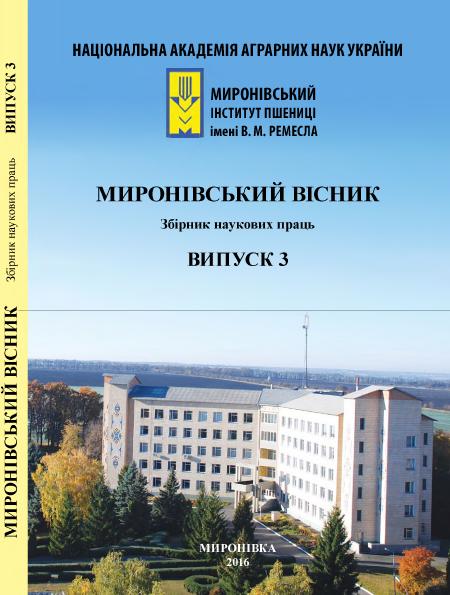Перехресна стійкість калюсних ліній тритикале озимого до комплексу абіотичних стресорів
Ключові слова:
Triticale, сольовий стрес, осмотичний стрес, стійкість, вільний пролін, калюсні лінії.Анотація
Мета. Проаналізувати рівень перехресної стійкості отриманих соле-і осмостійких калюсних ліній тритикале озимого як до осмотичного, так і до сольового стресів.
Матеріал і методика. Матеріалом досліджень були форми тривидового гексаплоїдного тритикале озимого миронівської селекції Лінія 38/1296 і сорт Обрій Миронівський. Використовували методи культури тканин із застосуванням селективних систем з манітом і хлоридом натрію.
Результати. Встановлено, що стабільність прояву ознаки перехресної стійкості до сольового і осмотичного стресів у отриманих клітинних ліній була досить високою – до кінця шостого пасажу виживало від 50 до 76% калюсів. Показано, що при наявності в селективному середовищі сублетальної концентрації стрес-фактора стійкі калюси активно продовжували накопичувати біомасу. Солестійкі клітинні лінії обох генотипів характеризувалися також підвищеним вмістом вільного проліну.
Висновки. Оцінка стійкості до абіотичних стресорів свідчить про достатньо високий рівень перехресної толерантності отриманих калюсних ліній тритикале як до сольового, так і до осмотичного стресів. У подальшому необхідно перевірити збереження стійкості в рослинах-регенерантів та їх насіннєвих поколіннях.
Посилання
Oettler G. The fortune of a botanical curiosity – Triticale: past, present and future. J. Agric. Sci. 2005; 143(5): 329-346.
Rybalka OI, Morgun VV,Morgun BV, Pochynok VM. Agronomic potential and perspectives of triticale. Fiziologiya Rastenii i Genetika – Plant Physiology and Genetics. 2015; 47(2): 95-111.
Kavanagh VB, Hall JC, Hall LM. Potential hybridization of genetically engineered triticale with wild and weedy relatives in Canada. Crop Sci. 2010; 50: 1128-1140.
Blum A. The abiotic stress response and adaptation of triticale – a review. Cereal Res. Commun. 2014; 42(3): 359-375.
Orlovskaya OA, Khotylyova LV. Assessment for resistance to biotic and abiotic factors of winter triticale hybrids created on the basis of samples of different ecological and geographical origin. Molekulyarnaya i Prilkadnaya Genetica – Molecular and Applied Genetics: Collected Works.InstituteofGeneticsand Cytology of NAS ofBelarus.Minsk. 2013; 14: 77-83.
Avdeev YuI,Slashcheva LA.Stability of winter Triticale to extreme abiotic factors of the environment in the arid zone of cultivation. Astrakhanskiy Vestnik Ekologicheskogo Obrazovaniya –AstrakhanBulletin of Ecological Education. 2014: 29(3): 84-87.
Blum A. Drought resistance, water-use efficiency, and yield potential – are they compatible, dissonant, or mutually exclusive? Austr. J. Agric. Res. 2005; 56(11): 1159-1168.
Krasensky J, Jonak C. Drought, salt, and temperature stress-induced metabolic rearrangements and regulatory networks. J. Exp. Bot. 2012; 63(4): P. 1593-1608.
Bartels D, Sunkar R. Drought and salt tolerance in plants. Crit. Rev. Plant Sci. 2005; 24(1): 23-58.
Zhu J-K. Salt and drought stress signal transduction in plants. Ann. Rev. Plant Biol. 2002; 53: 247-273.
Dubrovna OV, Morgun BV. Cellular selection of wheat for resistance to stress factors of environment. Fiziologiia i Biokhimiia Kul’turnykh Rastrenii – Physiology and Biochemistry of Cultivated Plants. 2009; 41(6): 463-475.
Reshetnikov VN, Spiridovich EV, Nosov AM. Plant biotechnology and perspectives of its development. Fiziologiya Rastenii i Genetika – Plant Physiology and Genetics. 2014; 46(1): 3-18.
Cheng-he Z, Jun C, Wen-kui B. Selection and characterization of high pH resistant or salt resistant variants from haploid Triticale callus (n=28). Acta Bot. Sin. 1986; 28: 137-144.
ShouXi C, Kleijer G. Effects of Fusarium metabolites on growth of callus and seedling in triticale. Acta Prataculturae Sin. 2001; 10: 78-85.
Abdrasheva KK, Tagimanova DS, Khapilina ON, Kupeshev ZhS. Selection in vitro of pea and Triticale cultivars for resistance to abiotic stresses. Biology – the Science of the XXI Century: the 19th International Pushchino School Conference of Young Scientists. Pushchino; 2015. P 3-4.
Shakirova FM. Non-specific Plant Resistance to Stress Factors and its Regulation.Ufa: Gilem; 2001. 160 p.
SolovyanVT.Adaptation of cells то environmental factors. Characteristic of adaptive responses. Biopolimery i Kletka – Biopolimers and Cell. 1990; 6(4): 32-42.
Gubanova NYa, Dubrovnaya OV, Chugunkova TV. The cell breeding of mangel beet resistant to several stress factors. Biopolimery i Kletka – Biopolimers and Cell. 2002; 18(3): 227-231.
Levenko BA, Pasternak EYu, Sidorova NV. Selection for resistance to water and salt stress in wheats. Abstr. VII Intern. Congr. Plant Tissue and Cell Culture. Amsterdam; 1990. P. 37.
Al-Kholani KhAM. Obtaining stress-tolerant maize plants by cellular selection. Thesis
Abstract for Candidate of Science (Biology): 03.01.05. Мoscow; 2010. 24 p.
ZinchenkoMO.In vitro selection of wheat for resistance to complex stressors. Thesis Abstract for Candidate of Science (Biology): 03.00.15. Kyiv; 2014. 20 p.
Belyanskaya SL, Shamina ZB. Obtaining and characteristics of rice clones resistant to stress factors. Fiziologiya Rasteniy – Russian Journal of Plant Physiology. 1993; 40(4): 681-685.
Pykalo SV,ZinchenkoMO, Voloshchuk SI, Dubrovna OV. In vitro selection of winter triticale for the resistance to water deficit. Biotechnologia Acta. 2015; 8(2): 69-77.
Murashige T, Skoog F. A revised medium for rapid growth and bioassay with tobacco tissue cultures. Physiol. Plant. 1962; 15(3): 473-497.
Andryushchenko VK, Sayanova VV, Zhuchenko AA, Modification of proline determination method for identification Lycopersicon Tourn drought-resistant forms. Izvestiya Akademii Nauk Moldavskoy SSR – News ofAcademy ofSciences ofMoldova SSR. 1981; 4: 55-60.
Lakin GF. Biometry.Moscow: Vysshaya Shkola; 1990. 352 p.
Sergeeva LE, Bronnikova LI, Tishchenko EN. The free proline content as the viability index of Nicotiana tabacum L. cell culture under stress conditions. Biotechnology. 2011; 4(4): 87-94.
Szabados L, Savoure A. Proline: a multifunctional amino acid. Trends Plant Sci. 2009; 15(2): 89-97.
Kolupayev YuE, Vayner AA, Yastreb TO. Proline: physiological functions and regulation of its content in plants under stress conditions. Visnyk Kharkivskoho Natsionalnoho Agrarnoho Universytetu – The Bulletin ofKharkivNationalAgrarianUniversity. 2014; 2: 6-22.
Chugunkova TV. The using of cell selection for creation of resistant forms of beet. Fiziologiia i Biokhimiia Kul’turnykh Rastrenii – Physiology and Biochemistry of Cultivated Plants. 2009; 41(6): 509-515.


